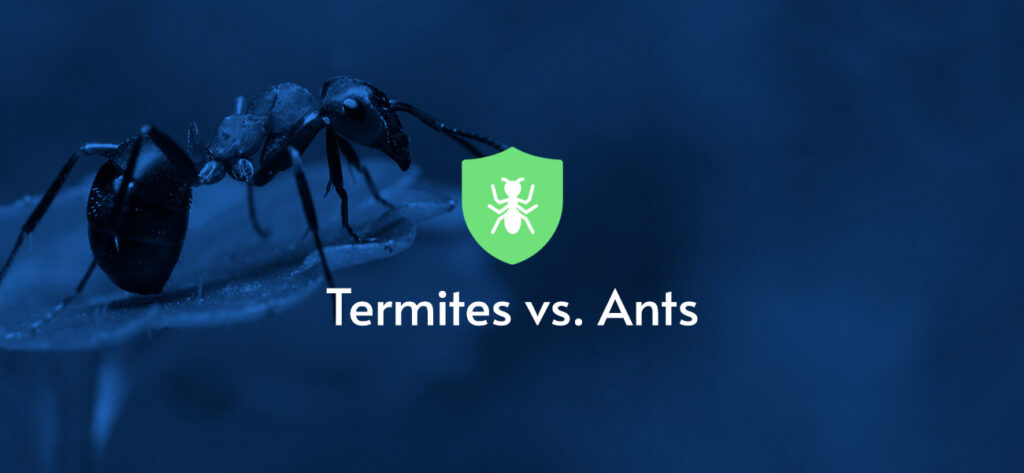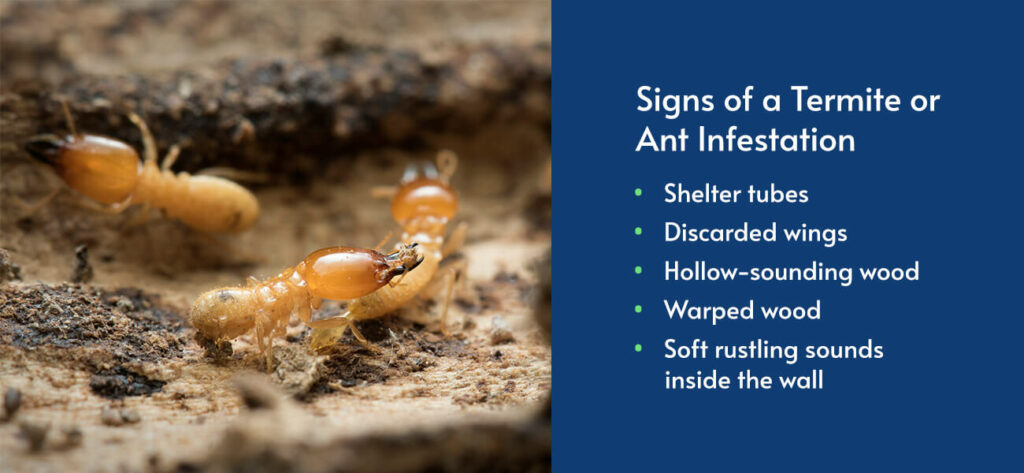Termites vs. Ants

Termites vs. Ants
Ants and termites are swarmers — the members of their reproductive castes grow wings and swarm during mating season. While most ant species behave differently than termites, some, like carpenter ants, cause similar damage. Knowing the differences between termites and ants can help you quickly identify an insect problem in your home or business. Continue reading to learn more!
Physical Differences
Flying ants and termites may appear indistinguishable, especially from a distance or when they fly straight at you. However, after swatting or looking at one under a magnifying glass, you will see several differences in their wings, body shape and size.
For instance, termite swarmers have:
- Black or dark brown bodies.
- Straight antennae.
- Four transparent, equally sized wings.
- A straight waist that is uniform with the rest of their body.
In contrast, flying ants have:
- Black, brown or reddish bodies.
- Kinked antennae.
- Two large front wings and two small hind wings, all brown-tinted.
- A pinched waist and three distinct body regions.
Though these differences are hard to spot from far away, they should help you quickly decide which pest is creating a problem from up close.
Carpenter Ants vs. Termites
Many people cannot tell whether they have carpenter ants or termites because these insects look so similar at first glance. Both species have wings, dark bodies and live inside wood in your home. Thankfully, several visual distinctions can help you distinguish between them.

Wing Length:
- Carpenter ants’ wings are just a little longer than their body.
- Termite wings are twice as long as their body.
Visibility:
- You may see a rogue carpenter ant inside your home, foraging for food.
- Unless the termites are swarming, you likely won’t see one inside your house.
Evidence:
- Carpenter ants push wood shavings and dead insect parts out of their tunnels.
- Signs of termites include droppings, wood damage and mud tunnels.
If you find an insect and you’re unsure if it’s a winged carpenter ant or termite, check it against these criteria. The wing size alone should tell you what you’re looking at.
Regardless of which insect it is, both species can cause severe damage when left unchecked. Don’t hesitate to find professional help to protect your home or business.
Diet Differences
The dietary differences between termites and ants are as stark as day and night. Ants are omnivores — meaning they eat anything from meat, eggs and dead insects to tree sap, grains and nectar. Ants particularly enjoy sweet foods, though some prefer meat over sweets.
In contrast, termites have a particular palate consisting of cellulose.
Several food sources contain cellulose, so termites eat more than one thing! Still, anything that lacks cellulose isn’t worth their energy to munch through. Common cellulose sources include wood, paper, cotton and hemp.
Various grains and vegetables contain cellulose, like sweet corn, Brussels sprouts, sugarcane and raw wheat bran. Yet, whereas cellulose makes up 24% of wheat bran, it comprises 70% of wood and up to 97% of cotton. Termites prefer more densely packed sources of cellulose. As termites can acquire wood easier than wheat bran, they focus their energies on the former but wouldn’t say no to the latter!
Life Cycle Differences
Ants go through complete metamorphosis, while termites go through incomplete metamorphosis. Complete metamorphosis involves four development stages — egg, larva, pupa and adult. Ant eggs are soft, oval and tiny, while the larvae look like small worms. Ant pupae resemble small adult ants with immature legs and antennae. Once they develop into adults, they become workers, male drones or female queens.
Incomplete metamorphosis involves three development stages — egg, nymph or larvae and adult. Termite eggs are white and oval, like tiny jelly beans. They hatch from eggs as nymphs or larvae and molt until they reach adulthood as worker, soldier or reproductive ants. Nymphs and larvae resemble their adult form immediately after hatching.
Termites also live longer than ants. Termite kings and queens can live for multiple decades, while workers and soldiers can live for three or more years. In contrast, ant queens may live up to 15 years, while workers typically live for a few months.
Ants and termites have similar reproductive activity. Winged reproductives fly from their colonies in spring and summer to start their own. Still, one reproductive difference between ants and termites is that male ants die shortly after mating with queens. Comparatively, male termite reproductives live on as kings of their colonies.
Habitat Differences
Most ants build nests underground or in soil mounds, but carpenter ants prefer living in rotting timber. Termites live near food and moisture sources, such as damp or dry wood. Unlike carpenter ants, which only use rotting timber for shelter, termites use healthy or rotting wood for food and shelter. Subterranean termites often build their nests in or near soil as they need moisture to survive.
Nests Differences
Termites build their nests from “carton” — a mixture of termite frass, or fecal matter, soil and chewed-up wood. You can find these nests in the soil, trees or wooden structures. Termites create shelter tubes of mud between their nests and food sources to pass to and fro safely.
Comparatively, ants dig tunnels underground, in soil mounds or rotting wood, to create nests. Ant nests have winding tunnels, chambers and rooms — enough space to store pounds of food and provide shelter for every ant in the colony.
Damage Differences
Carpenter ants are one of the only ant species that cause extensive structural damage to homes and businesses, since they build nests in wood. Other ant species may spoil food sources, damage your lawn or garden and pose hygienic issues. However, these ants won’t harm your home’s structure.
The same is not true for termites. Termite infestations mostly leave food alone, but that’s because they’re filling themselves up on the wooden beams and columns supporting your house!

Signs of a Termite or Ant Infestation
Knowing the differences between ants and termites is helpful if you think you have a termite or carpenter ant infestation. Here are some ways to identify termite infestation.
- Shelter tubes: If you notice mud tubes along your foundation or in cracks in the wall, termites may have built them to avoid predators.
- Discarded wings: After a male-female pair of swarming termites settle down and start a colony, they discard their wings and take their places as their colony’s king and queen. Discarded wings indicate a new colony has begun nearby.
- Hollow-sounding wood: Termites create tunnels in beams and columns as they consume the wood and make nests.
- Warped wood: As termites tunnel through wood, they cause warping. You may have tight-fitting doors or hard-to-open windows if they infest door frames or windowsills. You may also notice rippled paint or wallpaper.
- Soft rustling sounds inside the wall: When soldier termites sense danger, they bang their heads against the wall to alert worker termites.
Identifying carpenter ants might look like noticing:
- Food crumbs or debris in a line.
- Wood shavings in random areas.
- Damp or rotting wood.
- Soft rustling sounds inside the wall.
- Hollow-sounding wood.
- Small dirt or sand piles around your home.
While some of these indicators are similar, there are also notable distinctions between the evidence termites and carpenter ants leave around your home.
How to Deal With a Termite or Ant Problem
The best approach to termite or ant problems is to call a pest control expert for an inspection. At Pestech, we offer various baiting, spraying and fumigation services depending on what minimally invasive method will most effectively control your pest problem.
Baits and sprays are the primary control methods for ants and termites. We use baits for termites and monomorphic ants — ant colonies with workers of uniform size. We use sprays for carpenter ants and colonies of varying sizes. We prioritize green pest solutions that pose minimal health risks, keeping everyone in your household safe and responsibly eliminating your ant or termite infestation.
Contact Pestech Today to Deal With Your Termite or Ant Problem
For over 30 years, Pestech’s pest control specialists have provided safe and effective pest solutions to residents throughout New York state with exceptional customer service. If you have a termite or ant problem, a Pestech infestation professional will take care of the situation to secure your home or property from uninvited pests. Contact us today for an inspection!
Updated November 1, 2023

